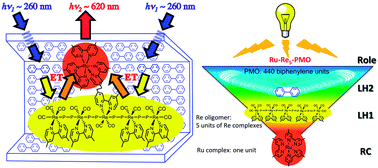Efficient light harvesting via sequential two-step energy accumulation using a Ru–Re5 multinuclear complex incorporated into periodic mesoporous organosilica†
Abstract
An efficient artificial light harvesting (LH) system was developed via sequential two-step energy accumulation. A periodic mesoporous organosilica with bridging biphenyl groups in the framework (Bp–PMO) was used as an LH antenna. The center of a linear-shaped Re(I) pentanuclear complex was connected to a Ru(II) trisdiimine complex through a covalent bond, these served as the first and second energy acceptors, respectively, (Ru–Re5). Hybridization was achieved with the non-ionic surfactant C12H25(OCH2CH2)4OH in an acetonitrile solution, and in the hybrid (Ru–Re5–Bp–PMO), the Ru–Re5 molecules were adsorbed in an orderly fashion in the mesopores of the Bp–PMO. Photons absorbed by 437 ± 43 of the Bp units were first accumulated in the five Re units in Ru–Re5 and then transferred to only one Ru unit, which emitted the light strongly.


 Please wait while we load your content...
Please wait while we load your content...